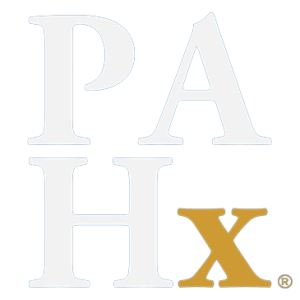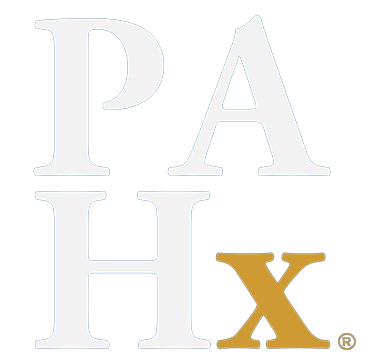PA Historical Perspectives
Articles and Essays
These articles and essays are drawn from resources found in our collection of archive, library, and museum holdings and from personal accounts. They are a way of showcasing and providing more in-depth information about events and people who have played a role in the development and growth of the PA Profession. Most of the articles and essays have been prepared by the Society and its staff, however, the Society will accept donated writings from third parties if deemed relevant and if they meet our quality standards. Articles are reviewed and approved by the PA History Society Board of Trustees and staff prior to being posted on the website.
Most of the articles require that you have Adobe Reader™ software installed on your computer to view.

DOUG BAKER: FIVE DECADES A GLOBAL PA
By Don Pedersen, PhD, PA
Doug Baker graduated from the 8th class of the University of Utah’s PA program. After graduation, his life as a “global PA” began. He has been dedicated to improving the quality of healthcare internationally for the entirety of his PA career. Read more about his fascinating experiences in this personal reflection from his long-time friend, Don Pedersen.
National PA week - origins and history
By Marilyn Fitzgerald, Honorary PA
Why was October 6th chosen as PA Day and later the start of PA Week? Why was PA Day changed to a week long celebration of the profession? Read this article to answer these questions and many more!
PHYSICIAN ASSISTANT INVOLVEMENT WITH THE AIDS EPIDEMIC, 1980S-1990S
By Reginald Carter, PhD, PA
The Physician Assistant History Society (PAHx) cofounder and Historian Emeritus, Reginald Carter, interviewed several PAs about their experiences during the HIV/AIDS epidemic of the 1980s and 1990s for an oral history interview collection. This essay gives an overview on the HIV/AIDS epidemic, shares personal recollections from PAs who were involved in HIV/AIDS healthcare or education, and tells how the AAPA LBGT Caucus was integral to educating and sensitizing the PA community on HIV/AIDS and LGBTQ+ issues.
THE ESTABLISHMENT OF THE PA PROFESSION IN THE NETHERLANDS
By Kenneth Harbert, PhD, MCHES®, PA-C Emeritus, DFAAPA
The Physician Assistant History Society (PAHx) and Kenneth Harbert recently developed an oral history project that discusses the development of the PA profession in the Netherlands through a series of video interviews. In less than twenty years, the Netherlands has developed a profession that has made a tremendous impact on the country’s health care policy, access, and delivery. There are now over 1,000 PAs practicing in the Netherlands. Currently, PAs in the Netherlands are an autonomous medical profession working in a collaborative setting with physicians.
FINDING A NICHE FOR MEDICALLY TRAINED VETERANS IN CIVILIAN HEALTHCARE 1970S
By Reginald Carter, PhD, PA
The 1960s was in the midst of a shortage of healthcare personnel while thousands of men and women with healthcare skills were being discharged from the military. The MEDIHC and the MEDEX Communication Center were created to help these veterans match with either employers or educational centers to help use their learned skills in the civilian sector.
THE VETERANS ADMINISTRATION’S ROLE IN HELPING ESTABLISH THREE LEGACY PHYSICIAN ASSISTANT PROGRAMS
By Reginald Carter, PhD, PA
This article looks at the role the Veterans Administration’s support and funding helped with the establishment of the Duke, Oklahoma and Baylor PA programs and the spread and acceptance of the PA profession.
ONCE WE WERE MANY, NOW WE ARE ONE THE LIFE PATHS OF THE PHYSICIAN ASSOCIATES FROM THE STONY BROOK CLASS OF 1975©
By Kenneth Harbert and Elizabeth Rothstein
The history of the founding of Stony Brook’s PA program and recollections from the first class.
AAPA WOMEN’S INTEREST CAUCUS AND THE EQUAL RIGHTS AMENDMENT
By Marilyn Fitzgerald, Honorary PA
Learn more about the history of the ERA and the founding of the AAPA’s Women’s Interest Caucus.
FROM MAC TO AHC: THE HISTORY OF THE MINORITY AFFAIRS COMMITTEE TO THE AFRICAN HERITAGE CAUCUS
By John J. Davis, PA-C, DFAAPA
The following exhibit was taken from a series of four articles written by PAHx Trustee John J. Davis, PA-C, DFAAPA. Mr. Davis shares several stories about the establishment of the AAPA Minority Affairs Committee and the African Heritage Committee, and the people who were involved in creating advancement opportunities for PAs of color throughout the profession.
REMEMBERING PHILIPPI, WEST VIRGINIA, ALDERSON-BROADDUS COLLEGE AND DR. HU MYERS
By Reginald D. Carter, William Stanhope, and Glen E. Combs
This shared memoir is based on an oral history interview conducted with Mr. Stanhope and Mr. Combs on October 8, 2020 by Dr. Carter. An edited version of the interview and transcript can be found in our oral history collection. Stanhope was a PA teaching fellow at Alderson-Broaddus (AB) College from 1969 to 1970 while Combs was a PA student and later a house officer at AB College and the Myers Clinic/Broaddus Hospital from 1971 to 1975. Dr. Myers established the first PA baccalaureate program at AB College in 1968. With Dr. Myers support and mentorship, the learning opportunities afforded Stanhope and Combs were unparalleled, given them confidence and experiences that would later shape their academic and clinical careers as PAs.
THE AMERICAN BOARD OF PHYSICIAN ASSISTANT PRACTICE: AS REMEMBERED BY WILLIAM STANHOPE AND CARL E. FASSER
By Reginald Carter, William Stanhope and Carl E. Fasser
The story of the ABPAP is indicative of the struggles and challenges faced by the PA profession during its third decade of existence, especially as more PAs chose to work in medical and surgical disciplines rather than family practice.
LITTLE KNOWN FACTS ABOUT DR. STEAD
By Reginald Carter, PhD, PA
What does KFC’s Sanders and Dr. Stead have in common? Read to find out!
USE OF THE TITLE “PHYSICIAN’S ASSISTANT” PRIOR TO 1965
By Reginald Carter, PhD, PA
Searching old USA newspapers using the keyword “physician’s assistants” produces some interesting results about how the term was used prior to 1965. So, how was the term “physician’s assistant” used prior to the formal education of PAs?
THE PURSER-MARINE PHYSICIAN ASSISTANT
By Reginald Carter, PhD, PA
The Pharmacist Mate (Marine Physician Assistant) Training program represents the cumulative efforts of many people over many years. It was born in need and carried forward by a sincere desire to bring shipboard medical care to all American seaman.” So began the introduction to a 1970 bulletin describing the newly established Purser-Marine Physician Assistant Program based at the U.S. Public Health Service (USPHS) Hospital, Staten Island, New York.
DR. STEAD’S WIFE, EVELYN, WAS AN INNOVATOR ALSO
By Reginald Carter, PhD, PA
“I never made much money doctoring. Mrs. Stead is the money maker in our family,” Dr. Stead once told Dr. Reginald Carter. Evelyn Stead co-authored an international bestseller in the 1960s, one of the first cookbooks to focus on healthy eating!
A FIRST HAND ACCOUNT OF THE FOUNDING OF THE AAPA VETERANS CAUCUS
By Kenneth Harbert, PhD, MCHES®, PA-C Emeritus, DFAAPA
Dr. Kenneth Harbert tells about his part in the building of the Vietnam Veterans Memorial, the Vietnam Women’s Memorial, and the formation of the AAPA Veterans Caucus
THE VETERANS CAUCUS AWARD PLAQUE
By Ken Harbert, PhD, MCHES®, PA-C Emeritus, DFAAPA
Dr. Kenneth Harbert tells the history of the AAPA Veterans Caucus’s prestigious award plaque, the story of the artist who inspired the award, and a list of the award winners starting at its inception.
THE CREATION OF GOD LOVES THE GRUNT
By Ken Harbert, PhD, MCHES®, PA-C Emeritus, DFAAPA
George Skypeck’s painting “God Loves the Grunt” contains thousands of names of Vietnam veterans who signed the artwork as it traveled throughout the USA in the 1980s. How the painting came about and how over 500 PAs came to sign it is a fascinating and emotional story. Prints of the painting and signatures have graced the walls of the White House and Congress and have appeared in the homes of military leaders and film and television stars. With the artist’s permission, the Veterans Caucus of the AAPA sells prints of the painting to generate scholarship funds for PA students who are veterans. “God Loves the Grunt” reminds us of the dedication and sacrifice of those first ex-military corpsmen who were selected to pioneer our profession. As such, the painting and artist have become an integral part of our professional history and legacy. *The official name for the Painting is “God Loves the Grunt”, though the article refers to it as “God Loves a Grunt”.
HONORING THOSE WHO SERVED: LCDR WILLIAM H. FEYH, PA-C, MSC, USN
By Reginald D. Carter, PhD, PA and Kenneth R. Harbert, PhD, MCHES®, PA-C Emeritus, DFAAPA
The Veterans Wall Exhibit and the PA Veterans Garden located at the Eugene A. Stead, Jr. Center for PAs in Durham, NC is the PA History Society’s way of honoring the pioneers of the PA profession who served as military corpsmen prior to becoming physician assistants. In 2011, the Navy Physician Assistant Association (NAPA) requested that a memorial service be held at the Stead Center in May to honor LCDR William H. Feyh who had died in 2005. Bill was president of the NAPA during 1993-1994. Those in attendance included Bill’s family, military colleagues, professional friends and faculty from the Duke University PA program from which he graduated in 1975. A plaque of remembrance was presented to the family and to the PA History Society to be displayed at the Stead Center.
PHYSICIAN ASSISTANTS THE WORLD OVER: ALVIN’S STORY
By Lt Michael R. Muni, MPA, MPH and Capt Robin Hunter- Buskey, PA-C
While deployed to Liberia in 2015 to work in the US Public Health’s Monrovia Medical Unit/Ebola Treatment Unit (MMU ETU), Capt Robin Hunter Buskey, PA-C, met a courageous Liberian educated Physician Assistant, Alvin P. Davis. She sent us a copy of Alvin’s story written by Lt Michael R. Muni who, in turn, gave us permission to publish as an exhibit.
As a PA working in the Good Will Clinic in the Flamah Community of Monrovia, Alvin contracted the Ebola virus in November 2014. Because he was a health care worker, Alvin was transferred to the US Public Health’s MMU/ETU for treatment. After aggressive medical interventions, Alvin became the first PA survivor for the MMU ETU. He was discharged on November 27, 2014 with a congratulatory ceremony and allowing him to place his painted handprint in recognition on the Ebola Survivor Wall with the other survivors. After his recovery, Alvin was hired by the Liberian Ministry of Health (MOH) as an Ebola Case Investigator based at the MMU. He worked along with USPHS officers, returning to the high-risk zone and encouraged patients through the lonely and trying periods of the Ebola virus epidemic.
Click here for Capt Hunter-Buskey’s photographs taken during her deployment to the USPHS MMU/ETU.
PROFILES IN BLACK
By Les Howard, PA
This booklet was produced by the African Heritage Caucus and distributed to members during the 25th Annual AAPA Conference held in Minneapolis, Minnesota, 1997. It contains brief biographies of PAs who are of African American heritage and who have become or who are in the process of becoming leaders in the PA profession. The booklet was made possible by the Howard PA Program and especially by Brenda Jasper who kept a history of the contributions of those highlighted in the booklet. As stated in the forward by Les Howard, “Having our history archived ensures that, we of African Heritage, maintain a presence, honor our elders, and pass the word to the next generation.”
The booklet presents individuals from three different generations of PAs and those who played an important role in establishing the African Heritage Caucus of the American Academy of Physician Assistants.
PHYSICIAN ASSISTANT PIONEER: WILLIAM G. ANLYAN, M.D.
By Ann Bliss, BS, RN, MSW, LCSW
PA History Society Trustee
Although Dr. Eugene Stead is the recognized father of the physician assistant profession, few people know that William Anlyan, M.D. was its uncle. As Dean of Duke University’s School of Medicine, Anlyan stood staunchly behind Stead’s decade-long innovative, but ill-fated, Masters Nurse Practitioner program in the 1950s. In addition, Anlyan’s influential leadership helped Stead’s subsequent PA concept gain federal funding as well as national recognition and replication in the 1960s and 1970s. It is important that we recognize individuals who “worked behind the scene” to sustain the PA Profession at a crucial time in its development.
MY TWO DAYS WITH JFK
By John Braun, PA, MPH
In this missive, Braun recalls his two encounters with President John F. Kennedy. The first contact occurred in 1960 when he was a senior in High School. He saw Senator Kennedy, a presidential candidate, in a motorcade; they made eye contact and “I felt an instant connection with someone of whom I had only slightly ever heard his name.” The next encounter was while Braun was in the Navy serving as an Operating Room Technician in Bethesda Naval Hospital. Kennedy had been assassinated and his body flown to Bethesda for an autopsy. Braun indirectly became involved in the events that occurred the evening of November 22, 1963.
ADVANCE FOR PHYSICIAN ASSISTANTS: PA HISTORY ARTICLES
By Pam Moyers Scott, MPAS, PA-C, Reginald D. Carter, PhD, PA and Adonna L. Thompson, MLS
The following articles prepared by the publication committee of the Society for Preservation of PA History appeared in Advance for Physician Assistants during 2005, 2006 and 2007. The articles cover a broad range of topics that are based on illustrations drawn from the Society’s growing collection of digital items including photographs, documents, pamphlets and artifacts. The articles trace the development of the American Academy of Physician Assistants, the Association of Physician Assistant Programs, the National Commission on Certification of Physician Assistants and the development of the profession in general.
FIRST PHYSICIAN ASSISTANT STUDENT MEDICAL CHALLENGE BOWL, 1991
By Reginald Carter, PhD, PA, Anthony Miller, MEd, PA-C, and Cynthia B. Lord, MHS, PA-C
In 1990, Cynthia B. Lord, the Student Academy of the American Academy of Physician Assistants (SAAAPA) liaison to APAP (now PAEA), met with APAP board members Anthony A. Miller and Albert F. Simon to discuss how they might entice more students to attend the AAPA’s annual conference. They came up with the idea to hold a Jeopardy-style, friendly competition that would match PA Program teams of three students, testing them on their medical knowledge. Therefore, the first Medical Challenge Bowl was held during the AAPA conference in 1991. Today, this event is considered a mainstay of the conference, and is funded by PA and medical organizations. In 2014, the NCCPA was a co-sponsor of the SAAAPA National Medical Challenge Bowl.
A PROTOTYPICAL MD/PA PRACTICE
By Dr. Reginald Carter, PhD, PA
Although generally recognized as the originator of the physician assistant concept, Dr. Eugene A. Stead, Jr. is the first to note that the idea was not his exclusively. Prior to the development of the physician assistant program at Duke University in 1965, many physicians were training their own assistants on the job. Stead was aware particularly of one such proprietary trained assistant, Mr. Henry Lee “Buddy” Treadwell, who was trained by and worked with Dr. Amos Johnson in general practice in Garland, North Carolina. This relationship crystallized Stead’s vision of how a physician’s assistant could be used to help over-worked doctors deliver health care services.
MARKETING THE PA PROFESSION
By Dr. Reginald Carter, PhD, PA
At a critical time in its development, the PA profession gained public attention from two unlikely sources of support — a television show promoter and novice script writer, Jerry Bredouw, and a syndicated newspaper cartoonist, Dick Moores. Both were intrigued by the plight of ex-military corpsmen whose clinical training and skills could not be readily used in the civilian health sector. Their stories are intertwined and reveal how serendipity helped market the PA concept to the American Public in 1970 through an episode of NBC’s THE BOLD ONES and the Chicago Tribune’s GASOLINE ALLEY COMIC STRIP.


